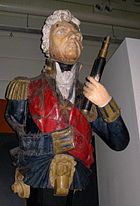| HMS Nelson (1814) | |
|---|---|
 HMVS Nelson, photographed between 1870 and 1879 | |
| Career (United Kingdom) | |
| Name: | HMS Nelson |
| Ordered: | 23 November 1805 |
| Builder: | Woolwich Dockyard |
| Laid down: | December 1809 |
| Launched: | 4 July 1814 |
| Fate: | Broken up, 1928 |
| Notes: | Screw ship from 1860 |
| General characteristics [1] | |
| Class & type: | Nelson-class ship of the line |
| Tons burthen: | 2617 bm |
| Length: | 205 ft (62 m) (gundeck) |
| Beam: | 53 ft 8.75 in (16.3767 m) |
| Depth of hold: | 24 ft (7.3 m) |
| Sail plan: | Full-rigged ship |
| Armament: |
126 guns: Gundeck: 32 × 32 pdrs Middle gundeck: 34 × 24 pdrs Upper gundeck: 34 × 18 pdrs Quarterdeck: 6 × 12 pdrs, 10 × 32 pdr carronades Forecastle: 2 × 32 pdr carronades |
HMS Nelson was a 126-gun first rate ship of the line of the Royal Navy, launched on 4 July 1814 at Woolwich.,[1] but then laid up incomplete at Portsmouth until 1854, when work began with a view to commissioning her for service in the Crimean War, but this ended before much work had been done, and the ship returned to reserve.[2]
She was converted into a screw ship in 1860, being cut down to a two decker and fitted with an engine of 2,102 indicated horsepower (1,567 kW) for a speed of 10.5 knots (19.4 km/h; 12.1 mph).
In 1865, Nelson was gifted to the colony of Victoria as a training ship, and she was finally outfitted and rigged for £42,000 and sailed for Australia in October 1867. Travelling via the Cape of Good Hope, she arrived in February 1868. She was the first ship to dock in the newly constructed Alfred Graving Dock. Her armament in 1874 was listed as two 7-in RML, twenty 64-lb guns, twenty 32-lb guns and six 12-lb howitzers.

The figurehead from Nelson, on display at the Australian National Maritime Museum
During 1879-82, Nelson was further cut down to a single deck and her rig reduced to the main mast only, the ship being reclassified as a frigate. Her old armament was partly replaced by modern breech-loaders. She was laid up at Willamstown in 1891, her boilers being removed in 1893. On 28 April 1898 she was put up for auction and sold to Bernard Einerson of Sydney for £2,400.[2]
In 1900. Nelson was cut down yet again to create a coal lighter that kept the name Nelson, the upper timbers being used to build a drogher named Oceanic. In 1908 "Nelson" was sold to the Union Steamship Co. of New Zealand, and in July was towed from Sydney to Beauty Point on the Tamar River, Tasmania, for use as a coal storage hulk. She later foundered there with 1,400 tons of coal on board and remained submerged for forty days until finally refloated.
In January 1915 she was towed to Hobart for further service as a coal hulk, until sold in August 1920 to Mr. H Gray for £500 and towed an up river to Shag Bay for gradual breaking up, work continuing into the 1930s,[3] although some of her timbers still survive.[2]

Guns from HMS Nelson in gardens at Ballarat.
The ship's figurehead was preserved by the NSW Naval Brigade, then the Royal Australian Navy, before it was presented to the Australian National Maritime Museum for display.[4]
Notes[]
References[]
- Lavery, Brian (2003) The Ship of the Line - Volume 1: The development of the battlefleet 1650-1850. Conway Maritime Press. ISBN 0-85177-252-8.
- Jones, Colin (1986) Australian Colonial Navies Australian War Memorial, ISBN 0-642-99479-X
External links[]
| Wikimedia Commons has media related to HMS Nelson (1814). |
The original article can be found at HMS Nelson (1814) and the edit history here.